|
INDEPENDENCE National Historical Park |
 |
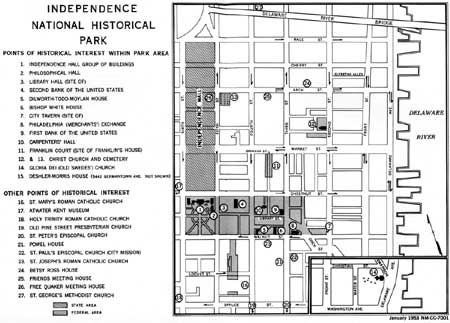
(click on image for an enlargement in a new window)
Guide to the Area
The information which follows supplements that contained in the narrative of this handbook. It is so arranged as to enable you to make your own tour of the area. The numbers given correspond to the numbers on the map of the and park and vicinity.
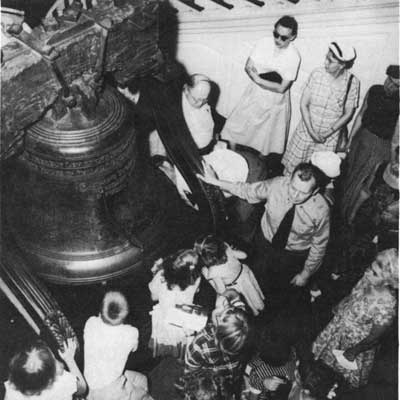
This group is typical of the more than one million
visitors who come annually from every corner of the world to see the
Liberty Bell.
NO. 1 INDEPENDENCE HALL GROUP, In dependence Square, comprises Independence Hall, east and west wings, Congress Hall, and the Supreme Court building (Old City. Hall). INDEPENDENCE HALL, the center building, was erected between 1732 and 1753 as the State House of the Province of Pennsylvania; here the Declaration of Independence was adopted on July 4, 1776, the Continental Congress met during the American Revolution, and the Federal Constitutional Convention sat in 1787. The Liberty Bell is located on the first floor of the tower. The WING BUILDINGS, erected originally in the 1730's, served as Provincial offices; they were torn down in 1812 and reconstructed in 1898. The buildings now serve as the Information Centers of the park. CONGRESS HALL, built as the County Courthouse in 1787—89, housed the Congress of the United States from 1790 to 1800. In the SUPREME COURT BUILDING, erected
In 1789—91 as the City Hall of Philadelphia, sat the Supreme Court of the United States from 1791 to 1800. These buildings are open from 9 a. m. to 5 p. m. daily, including holidays. You should begin your tour in the Information Center, west wing of Independence Hall.
NO. 2. PHILOSOPHICAL HALL (American Philosophical Society) on Independence Square. In 1785, the Assembly of Pennsylvania granted the lot to the society. The building, erected between 1785 and 1789, harmonizes in style with the other buildings on the square. The American Philosophical Society, the oldest and one of the most distinguished learned societies in America, was started in 1743 by Benjamin Franklin. The building, still occupied by the society, is not part of Independence National Historical Park and is not open to the general public.
No. 3. LIBRARY HALL, (site of Library Company of Philadelphia), on north east corner of Library and Fifth Streets. Founded in 1731 by Benjamin Franklin and his friends, the Library Company of Philadelphia was the first subscription library in the American Colonies. The structure was demolished about 1884. Its reconstruction by the American Philosophical Society is scheduled for 1956.
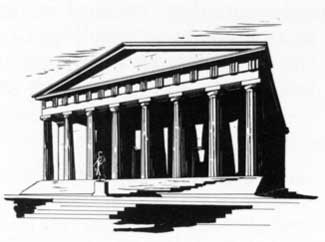
NO. 4. SECOND BANK OF THE UNITED STATES (Old Custom House), 420 Chestnut Street. The building, patterned after the Parthenon by the architect William Strickland, and considered one of the finest examples of Greek revival architecture in the United States, was erected between 1819 and 1824 to house the Second Bank of the United States. After a bitter controversy between President Jackson and the Whigs over the renewal of the charter, the bank closed in 1836. From 1845 to 1934, the building was the Philadelphia Custom House. In 1939, the Treasury Department transferred the building to the Department of the Interior. It has been partially restored to its original design under the guidance of the National Park Service. Now exhibited and maintained by the Carl Schurz Memorial Foundation, the building is open to the public Monday through Friday from 9 a. m. to 5 p. m. The park administrative offices are in this building.
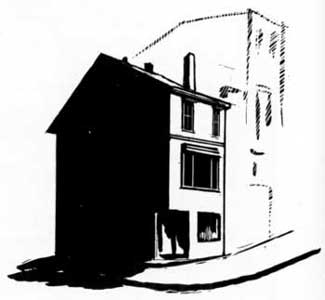
NO. 5. DILWORTH-TOOD-MOYLAN HOUSE, on northeast corner of Fourth and Walnut Streets. This small brick row house, typical of colonial Philadelphia, was built by Jonathan Dilworth, merchant, about 1775. From 1791 to 1793, it was the home of John Todd, Jr., and his wife, Dolly Payne. Following Todd's death during the yellow fever epidemic of 1793, his widow married James Madison, Congressman from Virginia, who later became the fourth President of the United States. From 1796 to 1810, it was the home of Gen. Stephen Moylan, mustermaster general and cavalry officer during the Revolution and commissioner of loans in 1793. The building is not open to the public pending its restoration by the National Park Service.
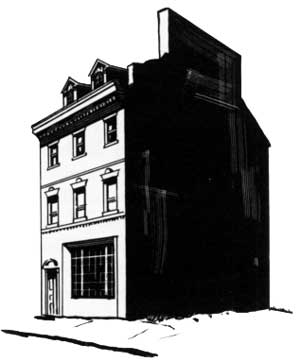
NO. 6. BISHOP WHITE HOUSE, 309 Walnut Street. This large brick residence, an excellent example of an early Philadelphia row house, was built shortly after the Revolution by the Reverend William White, Rector of Christ Church and St. Peter's Church from 1777, He became the first Bishop of Pennsylvania in 1787 and acted as a unifying force in reorganizing the Episcopal Church after the Revolution. After a long life of service to mankind, he died in his home on July 17, 1836. The building is not open to the public pending its restoration by the National Park Service.
No. 7. CITY TAVERN (site of), southwest corner of Second and Moravian Streets. A three-story structure, built about 1773, this was the most fashionable tavern in Philadelphia and was famous as the gathering place of members of the Continental Congresses and the Constitutional Convention and officials of the Federal Government from 1790 to 1800. The building was demolished about 1852.
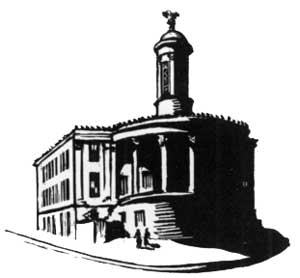
NO. 8. PHILADELPHIA (Merchants') EXCHANGE, on the northeast corner of Third and Walnut Streets. Built between 1832 and 1834, this building is noteworthy for the beauty of its architecture. For many years it was the meeting place for merchants and was the center of the commercial activities of Philadelphia. The building is not open to the public.
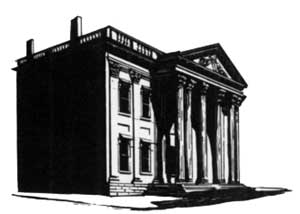
NO. 9. FIRST BANK OF THE UNITED STATES, on the west side of South Third Street, between Walnut and Chestnut Streets. Built between 1795 and 1797, this structure is probably the oldest bank building in the United States. The First Bank of the United States was established as part of the comprehensive program developed by Alexander Hamilton, Secretary of the Treasury, to rectify the disordered state of Government finances. The building, with its interesting classical facade, was occupied by the First Bank of the United States until the expiration of its charter in 1811. In the following year, the building was purchased by Stephen Girard, the wealthy merchant of Philadelphia, who opened his bank there. This building is not open to the public.
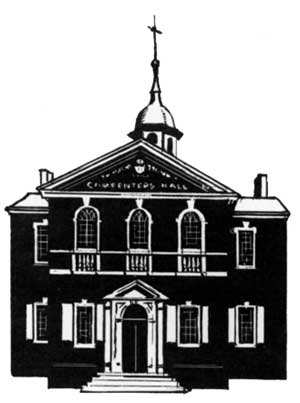
NO. 10. CARPENTERS HALL, 320 Chestnut Street. In September 1774, when the delegates to the first Continental Congress came to Philadelphia, they chose to meet in Carpenters Hall rather than the State House. The Hall, built in 1770, was the guild hall of the Carpenters' Company of Philadelphia, founded in 1724. In 1773, the building was also occupied by the Library Company of Philadelphia, whose books were used by the Continental Congress. Following the Revolution, the building was rented for many purposes by the Carpenters' Company. In 1857, they repaired the Hall and opened it as a historic shrine. The building and its grounds, still maintained by the Carpenters' Company of Philadelphia, is a part of Independence National Historical Park under a cooperative agreement with the Department of the interior and is open daily, except Sundays and holidays, from 9 a. m. to 4 p. m. free of charge.
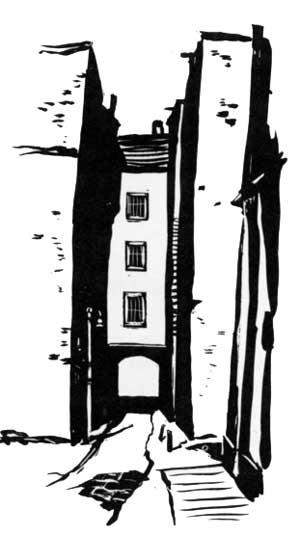
NO. 11. FRANKLIN COURT (site of Benjamin Franklin's home), on Orianna Street, south of Market Street. In this court, entered through a picturesque archway on Market Street, stood the imposing brick house of Benjamin Franklin from 1765 to 1812. Until 1785, Franklin lived in the house for only a year, since he served as Provincial agent in England from 1764 to 1775 and as a Commissioner to France from 1776 to 1785. In 1776, however, he served on the committee named by the Continental Congress to draft the Declaration of Independence. Upon his return to Philadelphia, he was elected President of Pennsylvania, and, in 1787, he was a delegate to the Federal Constitutional Convention. After a long and worthy life, Benjamin Franklin died in his home on April 17, 1790, at the age of 84. The house was demolished about 20 years after his death. Archeological investigation has uncovered parts of the original foundation of Franklin's house.
Nos. 12 AND 13. CHRIST CHURCH, on west side of Second Street, north of Market Street, and CEMETERY, at Fifth and Arch Streets. Founded in 1695 and built between 1727 and 1754, Christ Church, one of the most famous churches in America, had in its congregation many leading figures of the Revolution, including Washington, Franklin, Robert Morris, and Francis Hopkinson. Architecturally, the building, with its 200-foot steeple, is a monument to colonial craftsmanship—one of the largest and most beautiful structures in 18th-century America. Ecclesiastically, Christ Church is famous as the scene of the post-Revolutionary organization of the Episcopal Church. Its rector, William White, was the first Bishop of Pennsylvania and he second American prelate. Seven signers of the Declaration of Independence, as well as four signers of the Constitution, are buried at the church and in the cemetery. Franklin's grave is at the corner of Fifth and Arch Streets. The preservation of the church is assured by a cooperative agreement made in 1950 between the Department of the Interior and the Corporation of Christ Church. The church and grounds are open to the public from 9 a.m. to 5 p.m.
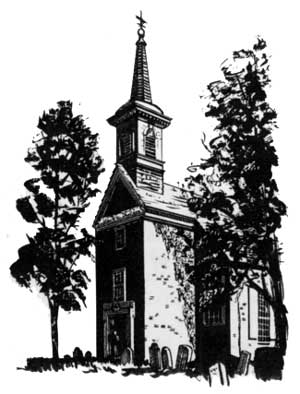
NO. 14. GLORIA DEI (OLD SWEDES') CHURCH, at Swanson Street and Delaware Avenue, is the oldest church building in Pennsylvania. The present structure, erected in 1700, replaced a log church built in 1677. The Swedes preceded the English to this part of the New World and began the Gloria Dei congregation in 1646. For almost two centuries this church was under the Swedish hierarchy, but after the Scandinavians had been absorbed into the general American population, Gloria Dei applied for admission into the Episcopal Church and was received by the Bishop of Pennsylvania in 1845. Swedish treasures are plentiful in the church to this day: many old documents and books; carved cherubim (imported in 1643); and the baptismal font. The church is nine blocks south from Market Street to Christian Street, then east to Delaware Avenue. Assurance that the church will be preserved unchanged is given in a cooperative agreement with the Department of the Interior. It is open to the public from 9 a. m. to 5 p. m. daily.
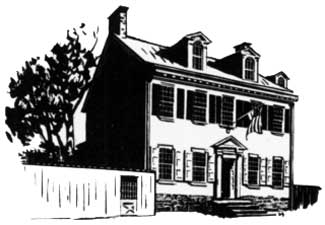
NO. 15. DESHLER-MORRIS HOUSE, 5442 Germantown Avenue. President Washington lived in this house during the fall of 1793 and summer of 1794.
It may be considered the oldest "White House" standing. Erected by David Deshler in 1772—73, it was bought in 1792 by Col. Isaac Franks, who had served in the Revolutionary War. The latter rented it to Washington, who moved out of Philadelphia during the yellow fever epidemic of 1793. Bequeathed by the Morris family to the United States Government in 1949, the house has been restored and is today exhibited by the Germantown Historical Society in cooperation with the National Park Service. It is open daily except Monday, from 2 p. m. to 5 p. m., with an admission fee of 25 cents for adults and 10 cents for children. The house may be reached by public or private transportation: north on Fifth Street to Germantown Avenue, then northwest about 3.5 miles.
Other points of historic interest in Old Philadelphia in the neighborhood of Independence National Historical Park are:
NO. 16. ST. MARY'S ROMAN CATHOLIC CHURCH, west side of South Fourth Street between Locust and Spruce Streets;
NO. 17. ATWATER KENT MUSEUM OF PHILADELPHIA, 15 South Seventh Street;
NO. 18. HOLY TRINITY ROMAN CATHOLIC CHURCH, northwest corner of South Sixth and Spruce Streets;
NO. 19. OLD PINE STREET PRESBYTERIAN CHURCH, southwest corner of Pine and South Fourth Streets;
NO. 20. ST. PETER'S EPISCOPAL CHURCH, southwest corner of Pine and South Third Streets;
NO. 21. POWEL HOUSE, 244 South Third Street;
NO. 22. ST. PAUL'S EPISCOPAL CHURCH (City Mission), east side of South Third Street and South of Walnut Street;
NO. 23. ST. JOSEPH'S ROMAN CATHOLIC CHURCH, south side of Walnut Street between Third and Fourth Streets;
NO. 24. BETSY ROSS HOUSE, 239 Arch Street;
NO. 25. FRIENDS MEETING HOUSE, Southside of Arch Street between Third and Fourth Streets;
NO. 26. FREE QUAKER MEETING HOUSE, southwest corner of North Fifth and Arch Streets;
NO. 27. ST. GEORGE'S METHODIST CHURCH, 235 North Fourth Street.

|

| History | Links to the Past | National Park Service | Search | Contact |
|
Last Modified: Mon, Dec 2 2002 10:00:00 am PDT |

